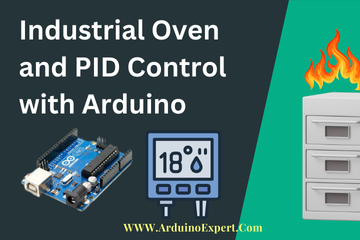In this Arduino Project, we will do Home or Office Window Automation and create a Smart Window System. In the age of smart homes and automated systems, the concept of controlling home environments has extended to include even the smallest details, such as window operation. Automatic window control systems are an excellent example of Arduino product design and development, where innovation meets functionality to optimize indoor conditions based on external environmental factors like temperature and wind speed. This project outlines the creation of a window automation system using an Arduino UNO R4 Wi-Fi board, temperature and wind sensors, and a DC motor with an encoder. Additionally, by integrating the Blynk IoT platform, users can monitor and control the system remotely through their smartphones — providing both convenience and peace of mind while demonstrating practical product design and development skills.
The system is designed to automatically open or close a window to optimize indoor comfort depending on the surrounding environmental conditions. For instance, the window will open when the indoor temperature exceeds a certain threshold, allowing for natural ventilation. Conversely, if high wind speeds are detected, the system will close the window to prevent damage or maintain indoor comfort. This project showcases the potential of Arduino-based product design and development, making it ideal for enhancing home comfort, improving energy efficiency, and protecting property — all through smart automation technology.

Window Automation Project Overview:

Components used in the Smart Window Project:
- Arduino UNO R4 Wi-Fi:
- The Arduino UNO R4 Wi-Fi serves as the main controller for the system. It reads data from the sensors, controls the DC motor, and connects to the Blynk IoT platform via Wi-Fi. The built-in Wi-Fi capabilities of the UNO R4 make it ideal for IoT applications.
- Temperature and Humidity Sensor:
- A temperature sensor (e.g., DHT22) measures the ambient temperature and Humidity. The data is used to determine when to open or close the window to maintain a comfortable indoor environment.
- Wind Speed Sensor (Anemometer):
- A wind speed sensor (anemometer) measures the speed of the wind. This data ensures the window is closed during strong winds to protect the interior from damage or discomfort.
- DC Motor with Encoder:
- The DC motor, equipped with an encoder, controls the movement of the window. The encoder provides feedback on the motor’s position, allowing for precise control over how much the window is opened or closed.
- Motor Driver (BTS7960):
- The high ampere motor driver interfaces between the Arduino and the DC motor, allowing the Arduino to control the motor’s speed and direction.
- Blynk IoT Mobile App:
- Blynk is a popular IoT platform that allows users to create a custom interface on their smartphones to monitor and control IoT devices. In this project, Blynk is used to remotely control the window and monitor sensor data. In this project, Blynk is used to remotely control the window and monitor sensor data. User can select the Auto Mode or Manual Mode with respect to requirements and can set temperature, humidity and wind speed limits for both modes. Moreover, we will do the calibration of encoder motor to find the maximum and minimum distance covered by window.
- Optional Components: Some other components can also be used like solar panel, batteries, charge controller, air quality sensor and many more. But it depends upon the requirements and budget of end user weheter to add more components or not.
Working of Smart Window System, Window Automation Project:
The window automation system operates by continuously monitoring temperature and wind speed. Based on predefined thresholds, the Arduino UNO R4 Wi-Fi controls the DC motor to adjust the window’s position. The Blynk app provides real-time monitoring and manual control, offering a user-friendly interface for managing the system remotely. User can select the Auto Mode or Manual Mode with respect to requirements and can set temperature, humidity and wind speed limits for both modes.
1. Sensor Integration and Data Acquisition:
- Temperature and Humidity Sensor: The DHT22 sensor is connected to the Arduino, providing real-time temperature and humidity data. SHT20 sensor can also be used instead of DHT22 for better accuracy.
- Wind Speed Sensor: The wind speed sensor, typically an anemometer, is connected to the Arduino to measure wind velocity.
2. Decision-Making Algorithm (in Auto Mode):
- The Arduino processes sensor data and makes decisions based on predefined conditions:
- High Temperature: If the temperature exceeds a certain threshold (e.g., 25°C), the Arduino will command the motor to open the window.
- High Wind Speed: If the wind speed exceeds a safe limit (e.g., 20 km/h), the Arduino will close the window to protect the interior.
3. Motor Control with Encoder Feedback:
- The DC motor with an encoder provides feedback on the window’s position. This ensures precise control, allowing the window to be partially or fully opened or closed based on the current conditions.
5. Wi-Fi Connectivity and Blynk Integration:
The Arduino UNO R4 Wi-Fi connects to the Blynk cloud server, enabling remote control and monitoring. The Blynk app on a smartphone provides a user interface with buttons, sliders, and displays for controlling the window and viewing sensor data in real-time.
Code for Smart Window System:
#include <DHT.h>
#include <BlynkSimpleEsp32.h>
#include <Encoder.h>
// Define pins
#define DHTPIN 2 // Temperature sensor pin
#define DHTTYPE DHT22 // DHT22 sensor
DHT dht(DHTPIN, DHTTYPE);
#define WIND_SENSOR_PIN A0 // Wind speed sensor pin
#define MOTOR_DIR_PIN1 3
#define MOTOR_DIR_PIN2 4
#define MOTOR_PWM_PIN 5
#define ENCODER_PIN1 6
#define ENCODER_PIN2 7
Encoder motorEncoder(ENCODER_PIN1, ENCODER_PIN2);
#define LIMIT_SWITCH_OPEN 8
#define LIMIT_SWITCH_CLOSED 9
// Blynk credentials
char auth[] = "YourBlynkAuthToken";
char ssid[] = "YourSSID";
char pass[] = "YourPassword";
void setup() {
Serial.begin(9600);
Blynk.begin(auth, ssid, pass);
dht.begin();
pinMode(MOTOR_DIR_PIN1, OUTPUT);
pinMode(MOTOR_DIR_PIN2, OUTPUT);
pinMode(MOTOR_PWM_PIN, OUTPUT);
pinMode(LIMIT_SWITCH_OPEN, INPUT_PULLUP);
pinMode(LIMIT_SWITCH_CLOSED, INPUT_PULLUP);
}
Calibration of DC Encoder Motor for Window Automation:
Calibration is needed in order to calculate maximum and minimum revolutions of dc motor for complete window opening and closing. the calibration process will be just one time and it will be done with the help Blynk IoT App.
Working Video Smart Window Automation Project:
https://www.youtube.com/watch?v=tAM4avkQPkU
Applications of Smart Window:
The window automation project, which utilizes temperature and wind sensors, a DC motor with an encoder, an Arduino UNO R4 Wi-Fi board, and the Blynk IoT mobile app, offers numerous practical applications across different environments. Its ability to automatically control window positions based on environmental conditions can be leveraged to improve comfort, energy efficiency, and safety in various settings. Below are detailed applications of this project:
1. Smart Homes
- Climate Control and Comfort: In smart homes, maintaining an optimal indoor environment is essential for comfort and energy efficiency. This automated window system can regulate indoor temperature by opening windows when it’s too warm inside and closing them when it’s too cold or windy. By integrating with other smart home devices, such as thermostats and HVAC systems, this project can contribute to a fully automated climate control system, enhancing comfort and reducing energy costs.
- Energy Efficiency: By optimizing natural ventilation, this system reduces reliance on air conditioning and heating systems, leading to lower energy consumption and cost savings. For example, during cooler evenings, the windows can be automatically opened to cool the house naturally, reducing the need for air conditioning.
- Remote Monitoring and Control: Through the Blynk IoT mobile app, homeowners can monitor and control their windows remotely. This feature is particularly useful when homeowners are away and want to ensure their home remains comfortable or to secure the property by closing all windows in case of unexpected weather changes.
2. Greenhouses
- Automated Ventilation
- Protection Against Extreme Weather
- Remote Farming Management
3. Commercial Buildings
- Office Climate Control
- Energy Savings
- Integration with Building Management Systems.
4. Schools and Educational Institutions
- Healthy Learning Environments
- Safety During Adverse Weather
- Energy Conservation in Schools.
5. Hotels and Hospitality Industry
- Enhanced Guest Comfort
- Energy Management
- Remote Monitoring for Maintenance.
6. Healthcare Facilities
- Optimizing Indoor Air Quality
- Energy Efficiency in Hospitals
- Remote Control for Facility Managers
7. Industrial and Warehouse Settings
- Temperature Regulation
- Protection of Goods
- Energy Savings
8. Residential Buildings in High Wind Areas
- Protection Against Wind Damage
- Energy Efficiency
- Remote Access for Homeowners
9. Historical Buildings
- Preserving Building Integrity
- Energy Conservation in Old Buildings
- Remote Monitoring for Conservationists
Need This Project?
If you need this Project with or without Modifications or Customization then you can contact us through WhatsApp. We can deliver you this Project in the Following Ways.
Project Code:
we can provide you Project Code along with Zoom Assistant, through Zoom meeting for Setup of this Project or any other Arduino Project of your need.
Fully Functional Project with Hardware/Components Shipment:
if you can not make this project yourself then you can use this option. We will assemble the Project and will ship it to your Doorstep with Safe Packaging.
Learn More about the services we offer.
How to Automate my Home or Office Window based upon different Weather Parameters? i want to control window remotely.
We can Automate the window by using Arduino as Micro controller and by using electric motor and sensors. How all the components should be chosen carefully with respect to window design and type.
What main components are needed in Smart Window system or Window Automation Project?
First of all you need the Microcontroller Board with Wi-Fi functionality (ESP32 or Arduino Uno R4 Wi-Fi) and the DC Motor with Driver and encoder. Then you can choose sensors (like temperature, humidity or wind) based upon specific requirements



